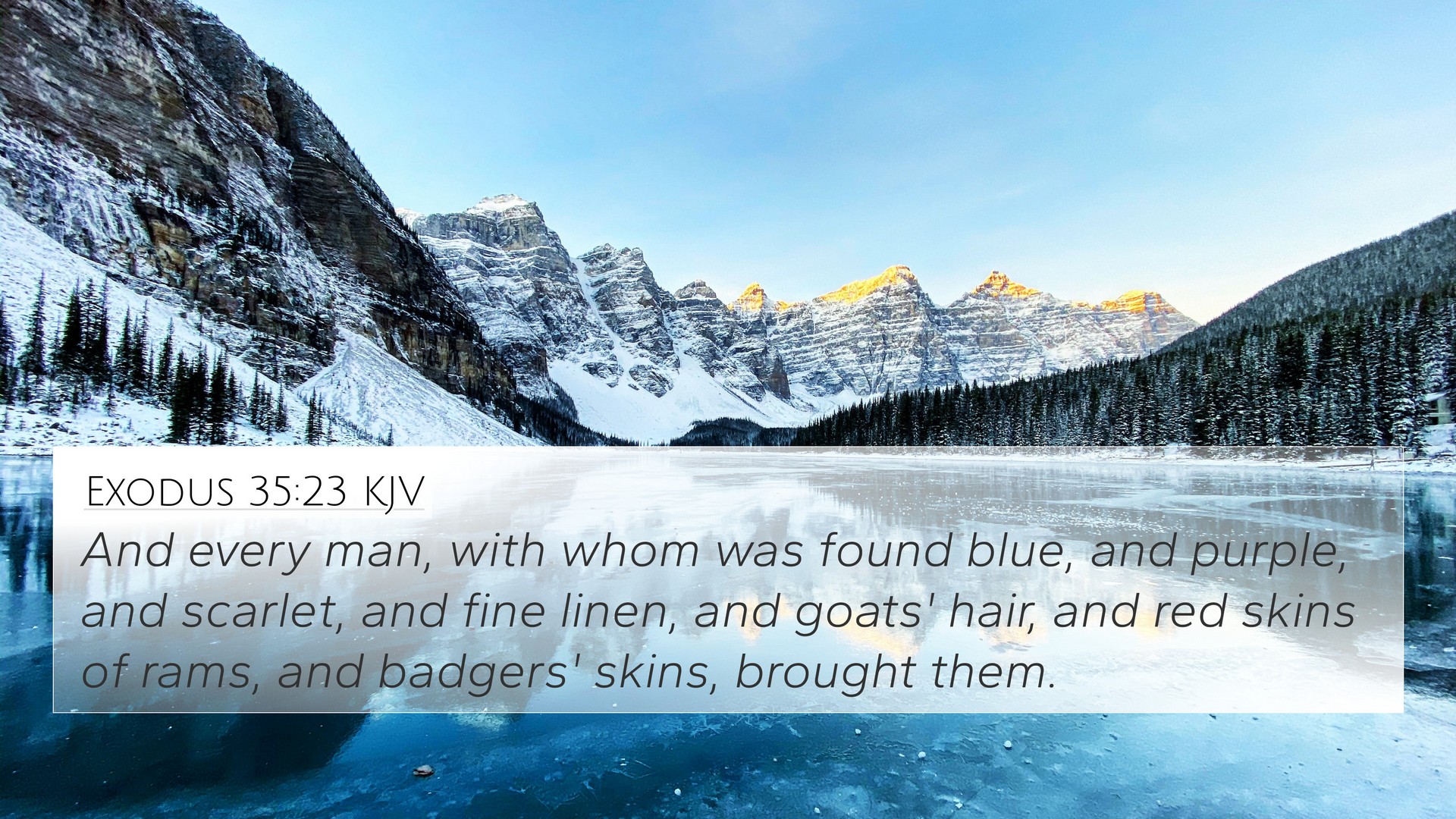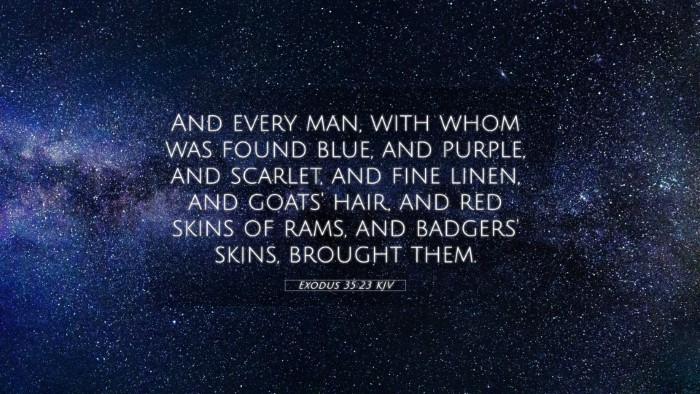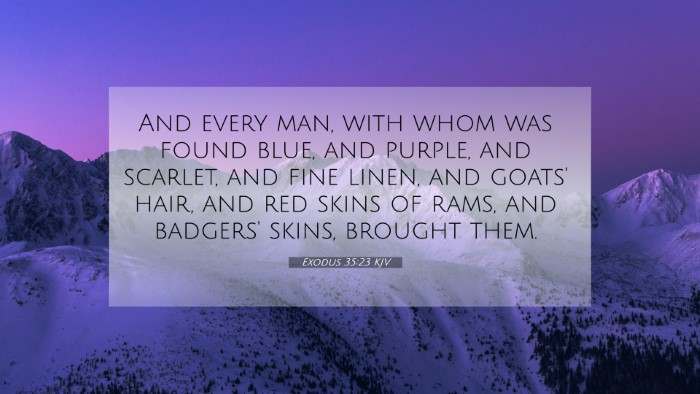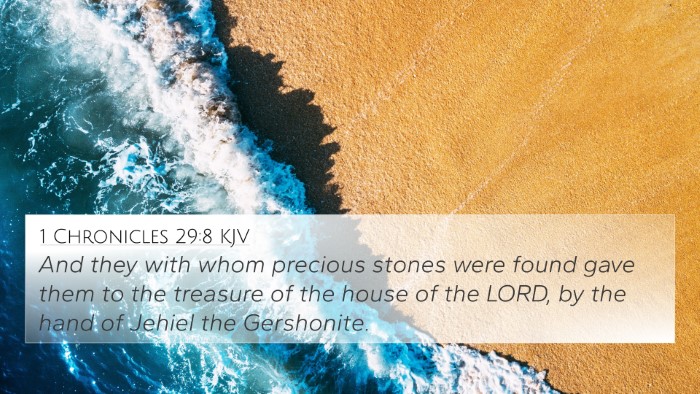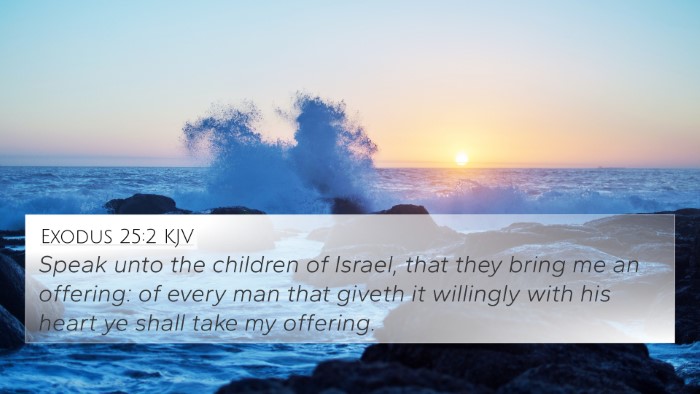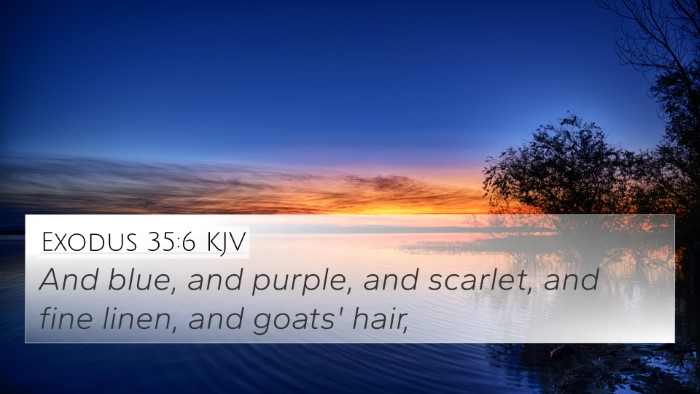Understanding Exodus 35:23
Exodus 35:23 states: “And every man, with whom was found blue, and purple, and scarlet, and fine linen, and goat's hair, and red skins of rams, and badgers' skins, brought them.” This verse highlights the offerings brought by the people of Israel for the construction of the Tabernacle. In analyzing this verse through the insights of public domain commentaries, we can glean a deeper understanding of its significance.
Verse Summary
In this passage, God commands the Israelites to contribute materials for the sacred Tabernacle, a dwelling place for His presence among them. The specific materials mentioned—blue, purple, and scarlet yarns, fine linen, goat hair, and various skins—hold both practical and symbolic importance in the construction.
Insights from Commentaries
-
Matthew Henry:
Henry emphasizes that the generosity of the people showcases their willingness to contribute to God’s work. He points out that the materials listed are rich and valuable, indicating the splendor and holiness of the Tabernacle that would house God's presence. The act of giving reflects the hearts of the people and their desire to serve and honor God.
-
Albert Barnes:
Barnes notes that the specific mention of colors and materials indicates their importance in the ceremonial practices of Israel. Each item signifies beauty, purity, and glory that God deserves, portraying a picture of holiness. He stresses that these offerings were not out of obligation, but willingly given as a response to God's grace and mercy.
-
Adam Clarke:
Clarke highlights the symbolic meanings of the colors and materials. For example, blue often represents the heavenly, purple signifies royalty, and scarlet suggests sacrifice. He suggests that the materials used in the Tabernacle should reflect the divine nature of God and the heavenly realities of worship. Clarke’s interpretation also taps into the idea of preparation for sacred service, inviting believers into a deeper relationship with God.
Connections to Other Bible Verses
To understand Exodus 35:23 in a broader biblical context, we can reference several related verses that provide a fuller picture of God's instructions for sacred worship and the response of His people:
- Exodus 25:1-2: God instructs Moses to collect offerings from the people for the Tabernacle, indicating a similar call for generosity.
- Exodus 36:3-7: The people brought more than enough materials for the Tabernacle, demonstrating God’s provision and the people's eager response.
- 1 Chronicles 29:2-9: King David's collection for the temple reveals a parallel attitude of generosity among God’s people, reflecting their commitment to His house.
- 2 Corinthians 9:7: Emphasizes that God loves a cheerful giver, resonating with the spirit in which the Israelites approached their contributions.
- Hebrews 9:1-5: Discusses the significance of the Tabernacle and its structure, linking the Old Testament practices to New Testament truths.
- Revelation 21:18-21: Describes the materials of the New Jerusalem, connecting the beauty and richness of the Tabernacle with God's ultimate promise to His people.
- Leviticus 14:4-7: Discusses the use of scarlet and hyssop in ceremonial cleansing, tying back to the colors used in the Tabernacle, symbolizing purification and holiness.
- Galatians 6:7: Speaks of sowing and reaping, reinforcing the principle that what one contributes to God’s work will bear fruit.
- Philippians 4:18: Paul applauds the gifts from the Philippians, comparing them to a sweet-smelling offering, akin to the materials offered in Exodus.
Thematic Connections
Exodus 35:23 encapsulates themes of:
- Generosity: Reflects the heart of the people willing to give to God’s mission.
- Holiness: Represents the sacred nature of the materials that reflect God's glory.
- Community Participation: Illustrates the collective effort of the Israelites in worship and service.
- Divine Presence: Points to God’s desire to dwell among His people through the Tabernacle.
Cross-Referencing Insights
This verse encourages a deeper study using tools for Bible cross-referencing. It serves as a starting point for identifying connections between Bible verses:
- Utilize a Bible concordance to explore keywords such as “offering,” “Tabernacle,” “sacrifice,” and “gifts.”
- Engage in cross-reference Bible study to explore themes of generosity and worship in both testaments.
- Apply cross-referencing study methods to find parallels between this offering and New Testament contributions.
- Employ Bible reference resources to discover the historical and cultural significance of the materials used.
- Link this verse to a comparative study of Pauline epistles to analyze the recurring themes of giving and service.
Conclusion
Exodus 35:23 serves not only as a historical account of offerings for the Tabernacle but as a rich text that connects many biblical themes and invites the believer into a deeper understanding of worship, community, and God’s glory. Through the insights of renowned biblical scholars, we can appreciate the profound importance of this verse in both the ancient context and its lasting implications for today’s faith practice.
